Chapter: Mathematics (maths) : Partial Differential Equations
Solution of a Partial Differential Equation
SOLUTIONS OF A PARTIAL DIFFERENTIAL EQUATION
A solution or integral of a partial differential equation is a relation connecting the dependent and the independent variables which satisfies the given differential equation. A partial differential equation can result both from elimination of arbitrary constants and from elimination of arbitrary functions as explained in section 1.2. But, there is a basic difference in the two forms of solutions. A solution containing as many arbitrary constants as there are independent variables is called a complete integral. Here, the partial differential equations contain only two independent variables so that the complete integral will include two constants.A solution obtained by giving particular values to the arbitrary constants in a complete integral is called a particular integral.
Singular Integral
Let f (x,y,z,p,q) = 0 ---------- (1)
be the partial differential equation whose complete integral is
f (x,y,z,a,b) = 0----------- (2)
where ŌĆ×aŌƤ and ŌĆ×bŌƤ are arbitrary constants.
Differentiating (2) partially w.r.t. a and b, we obtain

The eliminant of ŌĆ×aŌƤ and ŌĆ×bŌƤ from the equations (2), (3) and (4), when it exists, is called the singular integral of (1).
General Integral
In the complete integral (2), put b = F(a), we get
f (x,y,z,a, F(a) ) = 0 ---------- (5)
Differentiating (2), partially w.r.t.a, we get

The eliminant of ŌĆ×aŌƤ between (5) and (6), if it exists, is called the general integral of (1).
SOLUTION OF STANDARD TYPES OF FIRST ORDER PARTIAL
DIFFERENTIAL EQUATIONS.
The first order partial differential equation can be written as
f(x,y,z, p,q) = 0,
where p = ┬Čz/┬Čx and q = ┬Čz / ┬Čy. In this section, we shall solve some standard forms of equations by special methods.
Standard I : f (p,q) = 0. i.e, equations containing p and q only.
Suppose that z = ax + by +c is a solution of the equation f(p,q) = 0, where f (a,b)
= 0.
Solving this for b, we get b = F (a).
Hence the complete integral is z = ax + F(a) y +c------------ | (1) |
Now, the singular integral is obtained by eliminating a & c between
z = ax + y F(a) + c 0 = x + y F'(a)
0 = 1.
The last equation being absurd, the singular integral does not exist in this case.
To obtain the general integral, let us take c = F (a).
Then, z = ax + F(a) y + F (a) -------------- (2)
Differentiating (2) partially w.r.t. a, we get
0 = x + F'(a). y + F '(a) --------------- (3)
EliminatingŌƤbetweenŌĆ×a (2) and (3), we get the gene
Example 8
Solve pq = 2
The given equation is of the form f (p,q) = 0
The solution is z = ax + by +c, where ab = 2.
Solving, b = 2/b
The complete integral is
Z = ax + 2/a y + c ---------- (1)
Differentiating (1) partially w.r.t ŌĆ×cŌƤ, we
0 = 1,
which is absurd. Hence, there is no singular integral.
To find the general integral, put c = ’üå (a) in (1), we get
Z = ax + 2/a y + F (a)
Differentiating partially w.r.t ŌĆ×aŌƤ, we get
0 = x ŌĆō 2/ a2 y + F ŌĆś(a)
Eliminating ŌĆ×aŌƤ between these equations gives the general integral.
Example 9
Solve pq + p +q = 0
The given equation is of the form f (p,q) = 0.
The solution is z = ax + by +c, where ab + a + b = 0.
Solving, we get

Differentiating (1) partially w.r.t. ŌĆ×cŌƤ, we get
0 = 1.
The above equation being absurd, there is no singular integral for the given partial differential equation.
To find the general integral, put c = F (a) in (1), we have

Differentiating (2) partially w.r.t a, we get

Example 10
Solve p2 + q2 = npq
The solution of this equation is z = ax + by + c, where a2 + b2 = nab.
Solving, we get
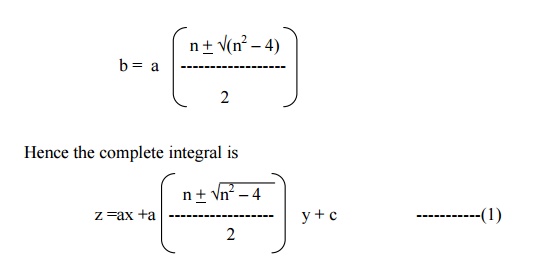
Differentiating (1) partially w.r.t c, we get 0 = 1, which is absurd. Therefore, there is no singular integral for the given equation.
To find the general Integral, put C = F (a), we get

The eliminant of ŌĆ×aŌƤ between these equations gives the general integral
Standard II : Equations of the form f (x,p,q) = 0, f (y,p,q) = 0 and f (z,p,q) = 0. i.e, one of the variables x,y,z occurs explicitly.
(i) Let us consider the equation f (x,p,q) = 0.
Since z is a function of x and y, we have

or dz = pdx + qdy
Assume that q = a.
Then the given equation takes the form f (x, p,a ) = 0
Solving, we get p = F(x,a).
Therefore, dz = F(x,a) dx + a dy.
(ii) Let us consider the equation f(y,p,q) = 0. Assume that p = a.
Then the equation becomes f (y,a, q) = 0 Solving, we get q = F (y,a).
Therefore, dz = adx + F(y,a) dy.
Integrating, z = ax + ├▓F(y,a) dy + b, which is a complete Integral.
(iii) Let us consider the equation f(z, p, q) = 0.
Assume that q = ap.
Then the equation becomes f (z, p, ap) = 0
Solving, we get p = F(z,a). Hence dz = F(z,a) dx + a F(z, a) dy.

Example 11
Solve q = xp + p2
Given q = xp + p2 -------------(1)
This is of the form f (x,p,q) = 0.
Put q = a in (1), we get
a = xp + p2
i.e, p2 + xp ŌĆōa = 0.
Therefore,
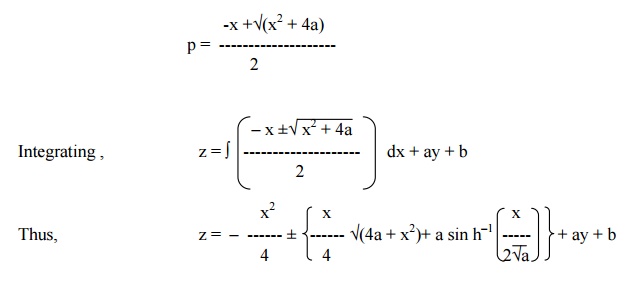
Example 12
Solve q = yp2
This is of the form f (y,p,q) = 0
Then, put p = a.
Therfore, the given equation becomes q = a2y.
Since dz = pdx + qdy, we have
dz = adx + a2y dy
Integrating, we get z = ax + (a2y2/2) + b
Example 13
Solve 9 (p2z + q2) = 4
This is of the form f (z,p,q) = 0
Then, putting q = ap, the given equation becomes
9 (p2z + a2p2) = 4
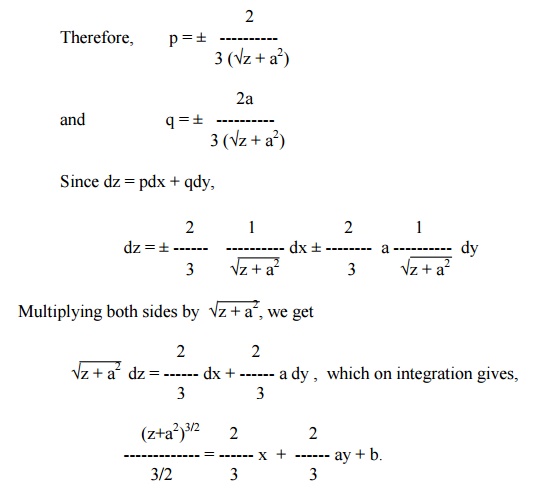
or (z + a2)3/2 = x + ay + b.
Standard III : f1(x,p) = f2 (y,q). ie, equations in which ŌĆśzŌĆÖ is absent and the variables are separable.
Let us assume as a trivial solution that
f(x,p) = g(y,q) = a (say).
Solving for p and q, we get p = F(x,a) and q = G(y,a).

Hence dz = pdx + qdy = F(x,a) dx + G(y,a) dy
Therefore, z = ├▓F(x,a) dx + ├▓G(y,a) dy + b , which is the complete integral of the given equation containing two constants a and b. The singular and general integrals are found in the usual way.
Example 14
Solve pq = xy
The given equation can be written as

Example 15
Solve p2 + q2 = x2 + y2
The given equation can be written as p2 ŌĆōx2 = y2 ŌĆōq2 = a2 (say)
p2 ŌĆōx2 = a2 Implies p = ├¢(a2 + x2)
andy2 ŌĆōq2 = a2 Implies q = ├¢(y2 ŌĆōa2)
But dz = pdx + qdy

Standard IV (ClairautŌĆÖs) form
Equation of the type z = px + qy + f (p,q) ------(1) is known as ClairautŌƤs
Differentiating (1) partially w.r.t x and y, we get p = a and q = b.
Therefore, the complete integral is given by
z = ax + by + f (a,b).
Example 16
Solve z = px + qy +pq
The given equation is in ClairautŌƤs. form
Putting p = a and q = b, we have
z = ax + by + ab -------- (1)
which is the complete integral.
To find the singular integral, differentiating (1) partially w.r.t a and b, we get
0 = x + b
0 = y + a
Therefore we have, a = -y and b= -x.
Substituting the values of a & b in (1), we get
z = -xy ŌĆōxy + xy
or z + xy = 0, which is the singular integral.
To get the general integral, put b = F(a) in (1).
Then z = ax + F(a)y + a F(a) ---------- (2)
Differentiating (2) partially w.r.t a, we have
0 = x + F'(a) y + aF'(a) + F(a) ---------- (3)
Eliminating ŌĆ×aŌƤ between (2) and (3), we get the general integral.
Example 17
Find the complete and singular solutions of
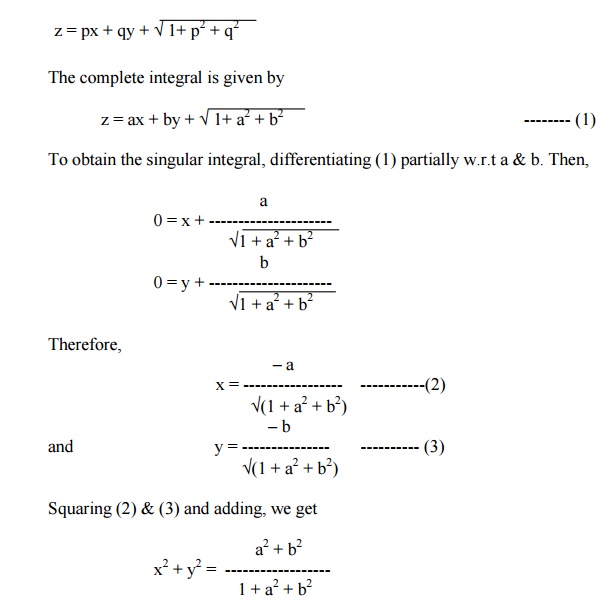
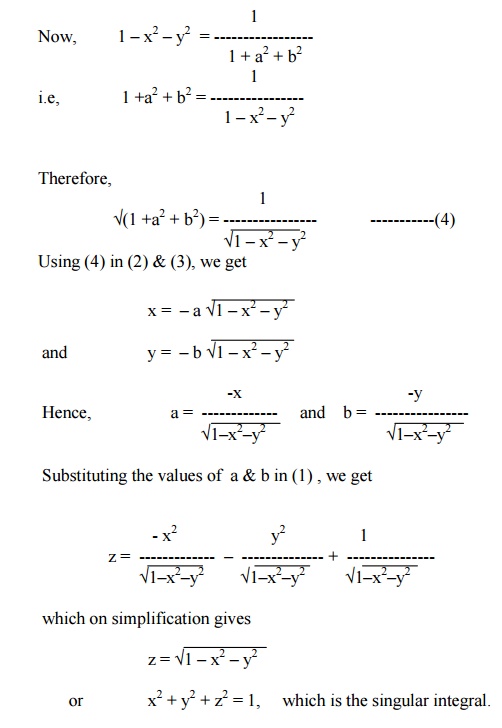
Exercises
Solve the following Equations
1. pq = k
2. p + q = pq
3. Ûp +Ûq = x
4. p = y2q2
5. z = p2 + q2
6. p + q = x + y
7. p2z2 + q2 = 1
8. z = px + qy - 2Ûpq
9. {z ŌĆō(px + qy)}2 = c2 + p2 + q2
10. z = px + qy + p2q2
EQUATIONS REDUCIBLE TO THE STANDARD FORMS
Sometimes, it is possible to have non ŌĆōlinear partial differential equations of the first order which do not belong to any of the four standard forms discussed earlier. By changing the variables suitably, we will reduce them into any one of the four standard forms.
Type (i) : Equations of the form F(xm p, ynq) = 0 (or) F (z, xmp, ynq) = 0.
Case(i) : If m ┬╣1 and n ┬╣1, then put x1-m = X and y1-n = Y.
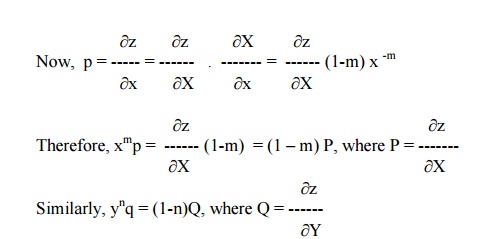
Hence, the given equation takes the form F(P,Q) = 0 (or) F(z,P,Q) = 0.
Case(ii) : If m = 1 and n = 1, then put log x = X and log y = Y.
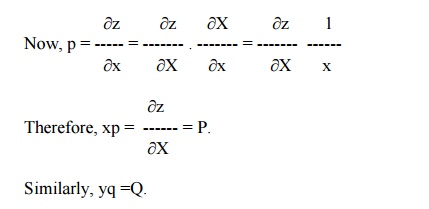
Example 18
Solve x4p2 + y2zq = 2z2
The given equation can be expressed as
(x2p)2 + (y2q)z = 2z2
Here m = 2, n = 2
Put X = x1-m = x -1 and Y = y 1-n = y -1.
We have xmp = (1-m) P and ynq = (1-n)Q
i.e, x2p = -P and y2q = -Q.
Hence the given equation becomes
P2 ŌĆōQz = 2z2 ----------(1)
This equation is of the form f (z,P,Q) = 0.
Let us take Q = aP.
Then equation (1) reduces to
P2 ŌĆōaPz =2z2
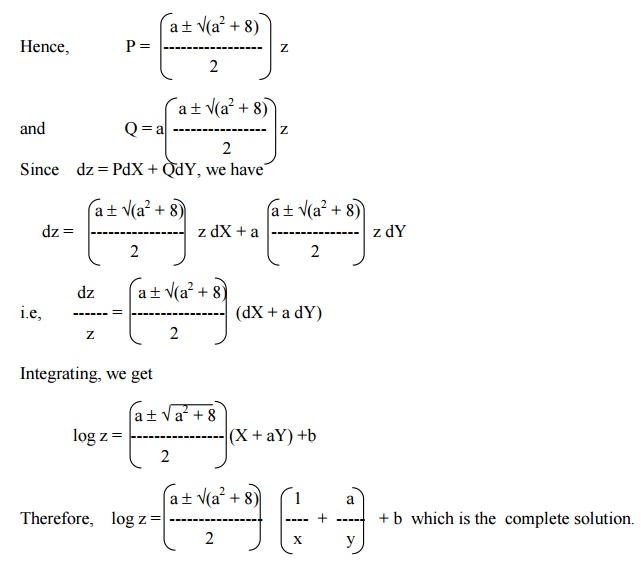
Example 19
Solve x2p2 + y2q2 = z2
The given equation can be written as
(xp)2 + (yq)2 = z2
Here m = 1, n = 1.
Put X = log x and Y = log y.
Then xp = P and yq = Q.
Hence the given equation becomes
P2 + Q2 = z2 ------------- (1)
This equation is of the form F(z,P,Q) = 0.
Therefore, let us assume that Q = aP.
Now, equation (1) becomes,
P2 + a2 P2 = z2

Integrating, we get
Û(1+a2) log z = X + aY + b.
Therefore, Û(1+a2) log z = logx + alogy + b, which is the complete solution.
Type (ii) : Equations of the form F(zkp, zkq) = 0 (or) F(x, zkp) = G(y,zkq).
Case (i) : If k ┬╣-1, put Z = zk+1,
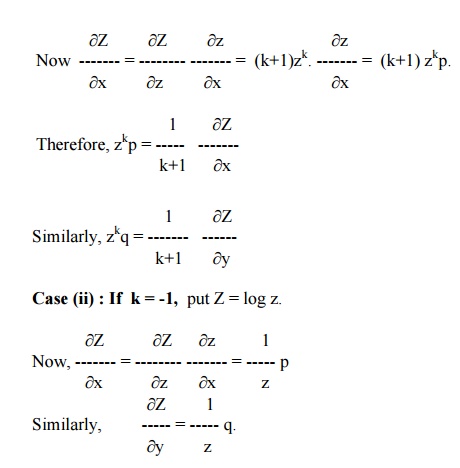
Example 20
Solve z4q2 ŌĆōz2p = 1
The given equation can also be written as
(z2q)2 ŌĆō(z2p) =1
Here k = 2. Putting Z = z k+1 = z3, we get
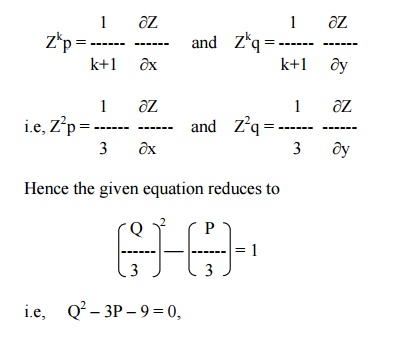
i.e, Q2 ŌĆō3P ŌĆō9 = 0,
which is of the form F(P,Q) = 0.
Hence its solution is Z = ax + by + c, where b2 ŌĆō3a ŌĆō9 = 0.
Solving for b, b = ± Û(3a +9)
Hence the complete solution is
Z = ax + Û(3a +9) . y + c
or z3 = ax + Û(3a +9) y + c
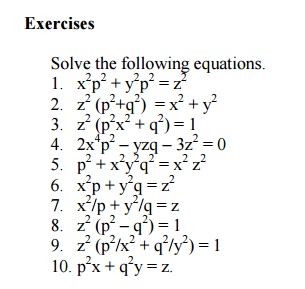
Related Topics